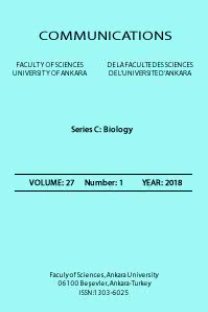SCREENING OF ANTIMICROBIAL AND ANTIOXIDANT ACTIVITY OF DIFFERENT TYPES OF HONEY SAMPLES OBTAINED FROM GEYIKLI (CANAKKALE) PROVINCE
Antimicrobial activity, agar well diffusion method, antioxidant activity, TEAC, honey
___
[1] C. Libonatti, S. Varela and M. Basualdo, Antibacterial activity of honey: A review of honey around the world, Journal of Microbiology and Antimicrobials. 6(3), (2014) 51-56.[2] J.M. A-Suarez, F. Giampieri, M. Battino, Honey as a source of dietary antioxidants: structures, bioavailability and evidence of protective effects against human chronic diseases, Current Medicinal Chemistry. 20, (2013) 621–638.
[3] F. M. Bueno-Costa, R.C. Zambiazia, B. W. Bohmer, F.C. Chaves, W. P. Silvaa, J.T. Zanussob, I.Dutra, Antibacterial and antioxidant activity of honeys from the state of Rio Grande do Sul, Brazil, Food and Science Technology. 65, (2016) 333-340.
[4] T. Eteref-Oskouei and M. Najafi, Traditional and Modern Uses of Natural Honey in Human Diseases: A Review, Iran Journal of Basic Medical Sciences. 16: (2013) 731-742
[5] S. Maurya, A.K. Kushwaha, S. Singh, G. Singh, An owerview on antioxidative potential of honey from different flora and geographical origins, Indian Journal of Natural Products and Resources. 5(1), (2014) 9- 19.
[6] N. Gheldof, X.H. Wang, N.J. Engeseth, Identification and quantification of antioxidant components of honeys from various floral sources, Journal of Agricultural and Food Chemistry. 50 (21), (2002) 5870-5877.
[7] A. Moussa, D. Noureddine, M. Abdelmelek, A. Saad, Antibacterial activity of various honey types of Algeria against pathogenic gram-negative bacilli: Escherichia coli and Pseudomonas aeruginosa. Asian Pacific Journal of Tropic Disease. Elsevier, (2012) 211-214.
[8] M. Balouiri, M. Sadiki, S. Koraichilbnsouda, Methods for in vitro evaluating antimicrobial activity: A review, Journal of Pharmaceutical Analysis. 6(2), (2016) 71-79.
[9] M. Cenet, A. Bozdogan, G. Sezer, L. Acar, Z. Ulukanlı, Antimicrobial activities, pollen diversity and physicochemical properties of natural honey from Southeastern Anatolia of Turkey, Advancements in Life Sciences. 4(2), (2017) 47-54.
[10] R. Re, N. Pellegrini, A. Proteggente, A. Pannala, M. Yang, C. Rice-Evans, Antioxidant activity applying an improved ABTS radical cation decolorization assay, Free Radical Biology and Medicine. 26 (9-10), (1999) 1231-1237.
[11] O. Escuredo, L.R. Silva, P. Valentao, M.C. Seijo, P.B. Andrade, Assessing rubus honey value: pollen and phenolic compounds content and antibacterial capacity, Food Chemistry. 130 (2012) 671-678.
[12] J.M. Alvarez-Suarez, S. Tulipani, D. Díaz, Y. Estevez, S. Romandini, F. Giampieri, E. Damiani, P. Astolfi, S. Bompadre, M. Battino, Antioxidant and antimicrobial capacity of several monofloral Cuban honeys and their correlation with color, polyphenol content and other chemical compounds, Food Chemical Toxicology. 48 (8-9): (2010) 2490-2499.
[13] F.M. Bueno-Costa, R.C. Zambiazi, B.W. Bohmer, F.C. Chaves, W. P. Silva, J.T. Zanusso, I. Dutra, Antibacterial and antioxidant activity of honeys from the state of Rio Grande do Sul, Brazil, Food Science and Technology. 65, (2016) 333-340.
[14] Z. Can, O. Yıldız, H. Sahin, E.A. Turumtay, S. Silici, S. Kolaylı, An investigation of Turkish honeys: Their physico-chemical properties, antioxidant capacities and phenolic profiles, Food Chemistry. 180, (2015) 133-141.
[15] S. Kolaylı, R. Aliyazıcıoğlu, E. Ulusoy, Ş. Karaoğlu, Antioxidant and antimicrobial activities of selected Turkish honeys, Hacettepe Journal of Biology and Chemistry. 36 (2), (2008) 163-172.
[16] O. Saral, Determination of antioxidant activities of the chestnut and flower honeys collected from Eastern Black Sea Region in Turkey, Journal of Apitherapy and Nature. 1 (1), (2018) 28-3
[17] O. Sagdıc, S. Silici, L. Ekici, Evaluation of the phenolic content, antiradical, antioxidant, and antimicrobial activity of different floral sources of honey, International Journal of Food Properties. 16, (2013) 658-666.
[18] M. Makarewicz, S. Kowalski, M. Lukasiewicz, M. Malysa-Pasko, Antimicrobial and antioxidant properties of some commercial honeys available on the Polish market, Czech Journal of Food Sciences. 35(5), (2017) 401-406.
[19] S. Soares, D. Pinto, F. Rodrigues, R.C. Alves, M.B.P.P. Oliveira, Portuguese honeys from different geographical and botanical origins: A 4-year stability study regarding quality parameters and antioxidant activity, Molecules. 22 (8), (2017).
[20] M.M. Özcan, C. Ölmez, Some qualitative properties of different monofloral honeys, Food Chemistry. 163, (2014) 212-218.
[21] O.M. Atrouse, S.A. Oran, S.Y. Al-Abbabi, Chemical analysis and identification of pollen grains from different Jordanian honey samples, International Journal of Food Science and Technology. 39, (2004) 413-417.
[22] I.C.F.R. Ferreira, E. Aires, J.C.M. Barreira, L.M. Estevinho, Antioxidant activity of Portuguese honey samples: Different contributions of the entire honey and phenolic extract, Food Chemistry. 114, (2009) 1438-1443
- ISSN: 1303-6025
- Yayın Aralığı: Yılda 2 Sayı
- Başlangıç: 1943
- Yayıncı: Ankara Üniversitesi
ALLERGENIC COMPOUNDS IN HONEY BEE PRODUCTS
THE ALLERGENIC POLLEN IN THE ATMOSPHERE OF EL-HADJAR CITY (ANNABA, ALGERIA)
INVESTIGATION ON POLLEN MORPHOLOGY OF TWO GAGEA SALISB. TAXA FROM TURKEY
Okan SEZER, Ali Can YILDIZ, Onur KOYUNCU, Koray YAYLACI, İsmühan POTOĞLU ERKARA
INVESTIGATION OF THE ANTIMICROBIAL ACTIVITY OF GAGEA
Basma Mansur Abdalrahim BADER, Talip CETER, Barış BANI
POLLEN MORPHOLOGY OF GYPSOPHILA LARICINA L. AND TAXONOMIC IMPORTANCE
İsmühan POTOĞLU ERKARA, Mustafa UYANOĞLU
SPORE MORPHOLOGY OF SOME TURKISH MOSS SPECIES
Merve CAN GÖZCÜ, Talip CETER, Guray UYAR
POLLEN MORPHOLOGY STUDIES ON TWO EUPHORBIA L. (EUPHORBIACEAE) TAXA FROM TURKEY
Ümmüşen GÖKÇEN, İsmühan POTOĞLU ERKARA, Okan SEZER, Onur KOYUNCU, Ömer Koray YAYLACI
HISTORY OF MELISSOPALYNOLOGICAL METHODS
Ömür Gencay CELEMLİ, Kadriye SORKUN
BIOLOGICAL AIRBORNE PARTICLES IN KIRSEHIR ATMOSPHERE EXCEPT FOR POLLEN AND FUNGAL SPORES
